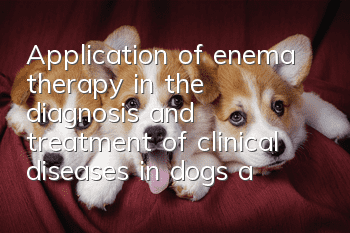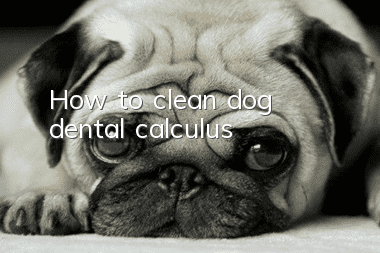Application of enema therapy in the diagnosis and treatment of clinical diseases in dogs and cats

With the improvement of people's living standards, more and more people are raising dogs in order to enrich their cultural life. However, due to people's lack of professional and scientific breeding knowledge, outdated concepts and bad living habits, factors such as poor care of dogs or dog breeds, feeding and management may occur. Immediately, some diseases are caused, especially in spring and autumn. Some dog owners are unaware and do not vaccinate regularly, resulting in many dogs suffering from canine parvovirus, canine distemper and other more troublesome infectious diseases. Although conventional drug treatments are effective, the results are not ideal. If enema therapy is added, it has a good therapeutic effect on various diseases of dogs and cats. Clinically, if enema therapy is used, it can relieve symptoms, improve the condition, shorten the course of the disease, and improve the curative effect.
The application of enema therapy to assist in the treatment of dog and cat diseases mainly includes the following four aspects: conscious enema to clear feces and its harmful substances; second, enema to reduce inflammation, stop bleeding, astringent, and stop diarrhea; third, enema to replenish fluids; fourth, enema to relieve fever. Practice has proven that in the course of many diseases in dogs and cats, timely enema therapy can alleviate symptoms, improve the condition, shorten the course of the disease, and improve the efficacy.
1. Remove feces and its harmful substances1.1 The impact of feces on the body of dogs and cats
The occurrence of feces is much higher than that of diarrhea, and feces also poses a threat to the lives of dogs and cats. It is believed that various pathogenic factors first cause autonomic nerve disorders and enhance sympathetic nerve excitability, inhibiting the movement, secretion, digestion, absorption and excretion functions of the digestive system. Reduces the exchange of substances between the digestive system and the circulatory system. Change the internal environment of the body. Abnormal fermentation of intestinal contents produces toxic substances. Abnormal proliferation of microorganisms produces toxins. Mechanical stimulation of feces and stimulation of toxins cause congestion, edema, bleeding, and melena in the intestines. Intestinal toxins absorbed into the bloodstream aggravate autopoisoning. Reduced bile secretion or obstruction of bile excretion into the intestine, increased reabsorption, and the use of drugs excreted through the biliary tract in animals under treatment may cause accumulation poisoning. To sum up, the impact of feces on the collective cannot be ignored. Not defecating for 24 hours is stagnation, and not defecating for 48 hours is constipation, which should be removed in time.
1.2 Clear rectal feces
When abnormalities occur in the tail, rectum, perirectum, anus, perineum, prostate, etc. of dogs and cats, rectal feces often results. On the contrary, rectal feces can also lead to the occurrence of the above diseases. Removing rectal feces is beneficial to the treatment and recovery of the above-mentioned diseases and prevents anterior gastrointestinal dysfunction caused by them. Removing rectal feces is relatively simple, generally using water, normal saline or Kaiselu. You can also use self-prepared rapid defecation liquid (sodium dihydrogen phosphate 16g, 6g sodium dihydrogen phosphate, 10ml glycerin, distilled water plus 100ml), inject appropriate amount into the rectum to cause defecation. Dogs and cats suffering from chronic renal failure should avoid fast defecation solutions as they may cause phosphorus absorption.
1.3 Remove stool and harmful substances from the large intestine
The reasons for the formation of large intestinal stool are complicated. In addition to the causes of rectal feces, various febrile and venereal diseases, liver disease, feline megacolon, feline trichophagia, obstetric diseases, paralysis, pelvic injuries, etc. can cause large intestine feces. Deep enema is used to clean large intestine feces. The liquid used needs to be prepared by yourself. Recipe: 10g sodium chloride, 10g sodium bicarbonate, 100ml glycerin, 1000ml distilled water, set aside. The general dosage is 20-30ml/kg of body weight. If it doesn’t work once, it can be repeated. However, this prescription should be disabled when dogs and cats are accompanied by metabolic alkalosis. The sodium bicarbonate can be removed from this prescription, and 20g of sodium chloride can be added or prescription 2 can be used instead. Prescription: 0.9% sodium chloride 20-30ml/kg body weight, lactulose 0.5ml/kg body weight, mix deeply. Prescription 2 can be used to treat constipation caused by various reasons, especially for dogs and cats suffering from liver and kidney dysfunction and chronic encephalopathy.
1.4 Obtain more information about the digestive tract
The more important significance of clearing rectal stool is to understand the condition of the digestive tract. By observing the defecation speed and posture of dogs and cats, as well as the quantity, shape, composition, color, character, and smell of stool, the time of stool, food composition, and presence or absence can be analyzed. Hemorrhage or melena, whether there is mucosal shedding, whether there are parasites, and whether further testing is needed can also give the owner an intuitive impression and play a role in understanding the condition in depth.
2 Enema treatment
2.1 Viral enteritis in dogs and cats
Chinese medicine prescription for treating viral enteritis in dogs and cats: Pulsatilla 15g, Coptis 15g, Phellodendron 15g, Qinpi 15g, Sophora charcoal 15g, Cypress charcoal 15g, Xueyu charcoal 15g. Different species have different dosages. Decoction, concentrate, and deep retention enema. Use once a day for three days.
2.2 Canine hemorrhagic gastroenteritis
Prescription: 0.1% potassium permanganate 20--30ml/kg body weight, heated to body temperature, deep retention enema, once a day for three days. Potassium permanganate has strong astringency, so you must grasp the timing when using it. It must be used after the intestinal toxins have been discharged, otherwise it will cause intestinal toxins.Toxins accumulate and are absorbed into the bloodstream, resulting in concentrated self-intoxication.
3. Enema rehydrationThe large intestine has an active running function of sodium. The absorption of Na+ forms a potential gradient that leads to the absorption of Cl-. The absorption of sodium chloride establishes an osmotic pressure gradient that leads to the absorption of water.
3.1 Method
Enema rehydration is used for dogs and cats that are severely dehydrated, have a weak heart, fail microcirculation, have cold extremities, and have a drop in body temperature, and are in an endangered state, but their owners still insist on rescuing them. While waiting for laboratory data, intravenous rehydration and intestinal rehydration are performed at the same time. The liquid must be heated to above normal body temperature. For intravenous rehydration, use a 1:1 solution (1 part of 0.9% sodium chloride, 1 part of 5% glucose). The liquid for intestinal rehydration should be heated to 40 degrees and 0.45% sodium chloride should be used. The method is to remove the filter of the infusion tube and connect it to the rubber tube. Apply lubricant to the wall of the tube and then slowly insert it into the rectum until it reaches the deep part. Then fix the infusion tube at the base of the tail with tape to prevent the infusion tube from coming out, open the water stop valve and start infusion. The infusion speed can be twice as fast as intravenous infusion. Take heating and insulation measures throughout your body. Use a monitor, place a urinary catheter, monitor urine output at any time, and adjust the liquid composition in a timely manner when the test results are available.
3.2 Effect
3.2.1 The heated liquid adds heat to the body, which is beneficial to restoring the activity of cells and enzymes.
3.2.2 Stimulate the intramural nerve excitement of the intestine to increase intestinal peristalsis.
3.2.3 Dilute intestinal toxins and reduce toxic effects
3.2.4 Boost liver and spleen function through absorption.
4. Enema to relieve feverIntestinal antipyretic is used for poisoning. In cases of high fever caused by convulsions and convulsions after poisoning, in order to quickly cool down, cold water enema is used while taking other cooling measures. The key is that the enema catheter should not be inserted too deep, and the cold water sucked in heat and then discharged to form a flowing enema. The amount of cold water should be determined according to the cooling situation. Generally, it will stop when the body temperature drops to 39.5 degrees, including other cooling measures, to prevent excessive cooling. Therefore, when performing physical cooling for high fever dogs and cats, the temperature should be measured at any time. .
5. Treatment cases5.1 Case 1:
Time: August 8, 2014, Dog breed: Labrador, Age: 4 months, Weight: 10k, Vaccine status: No vaccine has been given. The dog owner narrated: Yesterday, the puppy was bathed and not dried very well. Today, it suddenly felt bad, vomited a little, was accompanied by diarrhea, and blood streaks could be seen in the feces.
5.1.1
Clinical symptoms: vomiting, unformed feces, blood in the feces, depression, and sunken eye sockets.
5.1.2
Diagnostic method: Do a laboratory CPV test. The CPV test was enteritis-type canine parvovirus. Based on the clinical examination, it was initially determined to be canine parvovirus.
5.2 Case 2
Time: January 3, 2014, dog breed: Samoyed, age: 3 months, weight: 8kg, vaccine status: only two doses of imported vaccines were administered. Dog owner's narrative
: I bought some chicken bones when I went home on January 2, 2014. After I got home, I fed them to Xiongxiong (Samoyed dog). After that, I had a slight cough and started to have diarrhea at night, accompanied by bloodshot eyes.
5.2.1
Clinical symptoms: cough, diarrhea, and blood streaks in the stool.
5.2.2
Diagnostic method: Do a laboratory CPV test, and the CPV test is normal. It is initially determined to be hemorrhagic enteritis caused by bones.
5.3 Case 3: Time: March 12, 2014, Dog breed: Chuan Chuan, Age: 10 years old, Weight: 7kg, Vaccine status: All vaccines have been completed. The dog owner narrated: When walking the dog at night, he found that the dog had some problems with pooping. He squatted on the grass for a long time and could not poop.
5.3.1
Clinical symptoms: constipation
5.3.2
Diagnostic method: Preliminary examination revealed severe inflammation around the anus. The main reason was that the anal glands were not squeezed for a long time, causing anal inflammation.
6. Treatment measuresstrong>The treatment cycle is 5 days. While treating canine parvovirus, it is combined with enema therapy. (Cases 2 and 3 were treated only with enema therapy) The methods are as follows:
6.1 Preparation before treatment:
6.1.2. Preparation of warm soapy water. Add soap to boiling water until it becomes milky white. Use tap water to adjust to 37~38℃ and the concentration is about 0.1--0.2%.
6.1.3 Preparation of therapeutic drugs: Mix Yunnan Baiyao, Vidicon, Smecta, and non-irritating antibiotics with warm saline to form an appropriate amount of uniform 37~38°C paste liquid, and inhale it into a syringe for later use.
6.1.4 Dog restraint: Place the dog prone on the treatment table, and raise the two legs at the back of the treatment table so that the dog is in a low-front-to-back position. If the dog is more docile, you can have it stand upside down to perform the enema.
6.2 Specific steps:
6.2.1 Clear the intestinal contents (enema without leaving liquid). Cut off the dirty hair around the anus of the dog, apply external soap to the entire rubber catheter to keep it lubricated in the intestine, and slowly insert the round end from the anus. , while inserting, use a large syringe to inject the prepared warm soapy water solution from the other end of the rubber catheter. Try to insert the rubber catheter as deep into the intestine as possible, and inject an appropriate amount of warm soapy water according to the size of the dog's body. Generally, the dosage per time is 250-1000ml. . After the injection is completed, take out the catheter, clean and disinfect it, put the dog down, and let it drain the injected warm soapy water on its own. If the dog cannot expel on its own, the catheter can be re-inserted into the anus and the catheter pumped back and forth to drain out the injected warm soapy water and intestinal contents. Then repeat 1 more time.
6.2.2 After drug retention enema, after the dog is placed upside down and restrained, slowly insert the sterilized rubber catheter into the anus. According to the size of the dog, insert the rubber catheter as deep into the intestine as possible to ensure that the drug solution penetrates deep into the intestine. Slowly inject the prepared medicine into the catheter, and slowly pull the catheter out while injecting the medicine. When the catheter is 2/3 withdrawn, the medicine injection is completed, and then inject a small amount of warm saline to clean the medicine in the catheter. After the injection is completed, slowly withdraw the catheter. The affected dog still maintains a posture of low front and high back 5ndn, and uses the root of the dog's tail to press the blocked anus, gently rub the abdomen to ensure that the medicine is fully distributed into the intestines, and then put the affected dog down.
7. Treatment resultsAfter a week of treatment, it was found that enema therapy had a very obvious effect in the auxiliary treatment of canine parvovirus disease. During the 4-5 days of treatment, the dog developed symptoms.The dog obviously has an appetite and is in good spirits. And the blood streaks in the stool disappeared.
8. Analysis and discussionCanine parvovirus and canine distemper are most likely to occur when dogs are 3 to 9 months old. Due to many reasons, owners cannot manage their dogs perfectly, which leads to diseases. During the entire treatment process, it is recognized that enema therapy has a very obvious effect as an auxiliary treatment for canine parvoma. For different diseases, we have a lot of understanding during the treatment and care period. The main points are as follows: less activity during the illness, timely treatment and proper care, which can reduce the treatment time. Blow dry and thoroughly after every shower. Even on cloudy days and rainy days, observe. Pay attention to getting vaccinated regularly.
9. Preventive measures9.1 Dogs and cats should be vaccinated regularly. For dogs and cats that are vaccinated for the first time, the vaccine cycle is 15 days, with a total of three shots. For dogs and cats that have been vaccinated, the domestically produced vaccine is one shot every six months, and the imported vaccine is one shot per year.
9.2 Improve environmental sanitation, keep feedlots and workplaces clean, pay attention to timely disinfection, and control and eliminate pathogens in the external environment. This is an important step in preventing infectious diseases.
9.3 Quarantine of dogs and cats to detect sources of infection early. Use various diagnostic methods to conduct disease inspections on dogs and cats in order to detect diseases early and take corresponding measures in a timely manner to control and eliminate the source of infection.
9.4 Enhance the resistance of dogs and cats
9.4.1 Strengthen feeding and management, practice scientific breeding of dogs and cats, and enhance their disease resistance. Carry out various immunization procedures such as maternal immunization, weaning immunization, and booster immunization.
9.4.2 Adhere to regular preventive injections and timely supplementary injections to enhance the body's immunity.
10. SummaryWhen enema therapy is used to assist in the treatment of canine parvovirus disease, it is generally used once. If there is drug discharge after the first enema, it can be performed again on the second day, but cannot be used multiple times.
At the same time, enema therapy can treat a variety of digestive tract diseases, such as gastroenteritis, fecal constipation, and early intussusception. It can also be used when oral administration is difficult. It can also be used to cleanse the intestines before surgery or induce labor before delivery, remove intestinal gas, reduce fever, and supplement nutrients. To clear the intestinal contents (enema without leaving liquid), the amount of enema solution should be large, the injection pressure should be increased, the enema speed should be fast, and the dog should be allowed to excrete immediately after the enema is completed. Expelling intestinal contents, firstly, prevents the contents from producing toxins in the intestinal tract, and secondly, it is beneficial to the drug during drug enemaDirect contact with the intestinal mucosa to give full play to the efficacy of the drug; drug retention enema, drugs and liquids should be weakly irritating, the enema speed should not be too fast, and the amount of solution should not be too large. During drug enema, the dose of non-irritating drugs can be appropriately increased, such as Yunnan Baiyao, Vidicon, Smecta, etc.
- What should I do if my French bulldog vomits after eating dog food?
- How old does a husky need to be to become a dog?
- How to get rid of parasites in dogs and what should you pay attention to?
- What should I do to protect my dog’s food? Should he be beaten?
- What food is good for beagles to eat?
- Is it okay for dogs to eat chicken breast for a long time?
- What should I do if my dog doesn’t eat and is lack of energy?
- What are the disadvantages of the King Charles Spaniel?
- The reason why the little VIP drank so much water
- Diagnosis and treatment of cerebral hemorrhage in dogs



